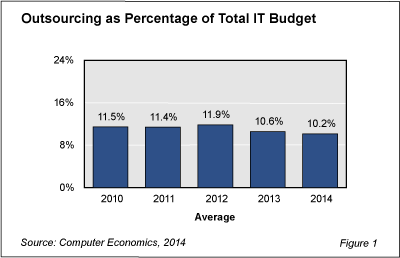IT outsourcing budgets as a percentage of the total IT budget dropped slightly this year, continuing the downward move for the second year in a row and signaling that organizations are investing in internal IT operations as the recovery reaches a more mature and sustainable phase.
As shown in Figure 1 from our study, IT Outsourcing Statistics 2014/2015, spending on outsourcing is averaging 10.2% of total IT spending this year, which is a slight decline from 10.6% in 2013 and a more significant drop from the 11.9% peak in 2012.

The study also finds that fewer organizations this year are outsourcing help desk, desktop support, and application maintenance functions. Other functions have flat year-over-year trend lines, including data center, application development, database administration, network operations, and disaster recovery outsourcing. They all are being outsourced at about the same frequency this year as the prior year.
On the other hand, there are areas where outsourcing is rising and rising significantly. More organizations are outsourcing IT security work, and the outsourcing of web operations is on an upward curve again as well. In this study, we also classify use of software-as-a-service (SaaS) as a form of application hosting outsourcing, and to no surprise, our study finds this form of outsourcing is on a steep upward trajectory.
As such, any discussion of outsourcing trends has to begin with clarity over the functions being discussed. The outsourcing of application development is very different from the outsourcing of help desk services.
“From a broad perspective, the most likely explanation for the downward tilt in outsourcing as a percentage of the total IT spending is the ongoing economic recovery,” said John Longwell, vice president of research for Computer Economics.
Among our respondents, IT operating budgets are rising 2.4% at the median this year, as reported in our companion study, IT Spending and Staffing Benchmarks 2014/2015. IT organizations are putting newfound resources into internal operations at a pace that is greater than their spending with IT service providers. IT outsourcing budgets are not necessarily shrinking so much as IT budgets are rising.
The trend most likely indicates that we are at a more mature phase in the recovery. In the early stages, IT organizations first turned to service providers out of reluctance to hire permanent staff. Now they are turning their attention to long-delayed system improvements and unfilled positions.
Here are other key findings from our IT Outsourcing Statistics 2014/2015 study:
-
Large organizations have re-emerged as the leaders in outsourcing this year. They are spending 7.4% of their IT budgets on outsourcing at the median, compared with 6.1% for small organizations and 4.6% for midsize organizations.
-
Application hosting is the most frequently outsourced function in the study, and the fastest-growing type of outsourcing. This reflects the growing strength of SaaS.
-
Organizations that outsource are favoring help desk and web/e-commerce operations as functions where they are moving the largest percentage of work to outside service providers. On the other hand, application hosting and IT security are functions where IT organizations tend to perform most of the work in-house.
-
The IT functions with the greatest potential for successfully reducing costs through outsourcing are help desk and desktop support. The functions with the greatest potential for improving service through outsourcing, meanwhile, are disaster recovery and web/e-commerce operations.
- The outsourcing of disaster recovery, web/e-commerce, data center operations, and network operations have emerged as the functions delivering the best value. The outsourcing of these functions can save money and improve service levels.
In the full study, we profile outsourcing activity for 11 IT functions: application development, application hosting, application maintenance, data center operations, database administration, desktop support, disaster recovery services, help desk services, IT security, network operations, and web/e-commerce systems.
For each IT function, we measure the frequency and level of outsourcing. We also look at the current plans of IT organizations to increase or decrease the amount of work they outsource. Finally, we examine the customer experience to assess whether organizations are successfully lowering costs or improving service through outsourcing.
This Research Byte is a brief overview of our report on this subject, IT Outsourcing Statistics 2014/2015. The full report is available at no charge for Computer Economics clients, or it may be purchased by non-clients directly from our website (click for pricing).

